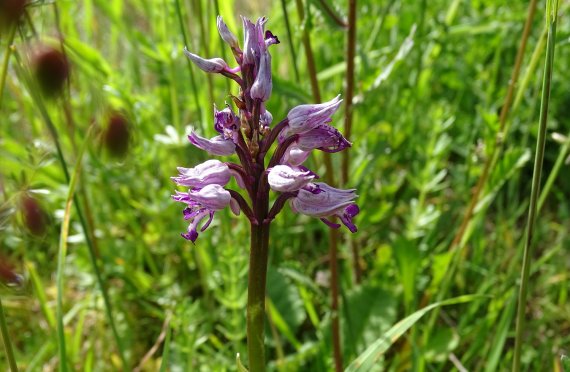Orchis militaris, a species new to the natural garden, was discovered there by the nematologist Joost Riksen. Riksen discovered the plant on a walk through the garden last week. He wondered whether this was a first sighting. Yes it was, responded the garden committee. ‘We are pretty excited about it,’ says ecologist Wieger Wamelijk, as we set off to have a look.
On the small side
The military orchid is not easy to locate, as the plant is barely 15 centimetres in height. On the small side, given that it can grow to nearly half a metre. That must be due to the dry weather. Wamelink comments that the garden is obviously suffering from the drought. ‘Much less is growing here than last year. The grass is even going yellow already. There is much less biomass and the plants are smaller and shorter.’
‘Orchid seeds are very fine and light, so they can be blown enormous distances.’
Wieger Wamelink, ecologist
‘You rarely see the southern marsh orchid at the moment,’ he continues. ‘Could well be that it stays completely underground. Then we might see it again next year.’ On the other hand, grass species are taking advantage of the dry weather. Snapdragons, for instance, and the dove’s foot geranium, a little pink flower that is often found in dry grasslands. Which is beneficial because it’s useful for insects.’

How the rare orchid ended up in the garden here is anyone’s guess. ‘Maybe Ger Londo, who designed the garden, sowed it back then,’ thinks Wamelink. ‘But it could also have blown in on the wind. Orchid seeds are very fine and light. They have a lot of air spaces in them, and can therefore be dispersed over vast distances. So that’s not the problem. This issue is the right environment to grow in.’
‘This orchid can’t cope with too much competition and needs a chalky soil with the right soil fungi’, explains Wamelink. These conditions are present in the garden. When it was created, the soil was impoverished by removing the topsoil and adding chalky marl soil from Limburg. In some ways, the garden is a little piece of South Limburg.
Pyramidal orchid
The military orchid is the seventh species to inhabit the garden. Some, including the southern marsh orchid, are found in large numbers. Others are rarer, such as the marsh helleborine, the broad-leaved helleborine and the early marsh orchid. The first pyramidal orchid was discovered here exactly two years ago. Wamlink spots one now too, while on the lookout for the military orchid.
Quite how the persistent drought will affect the biodiversity in the garden remains to be seen. But it can’t be good, of that Wamelink is certain. ‘I’m afraid we shall lose all the wet habitat species.’ He points to a mound a little way off. ‘Heather is growing there already. That’s beautiful too.’

 Photo: Joost Riksen
Photo: Joost Riksen